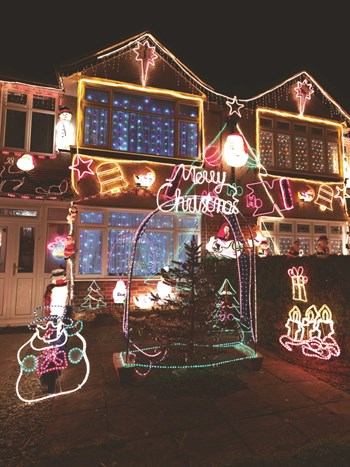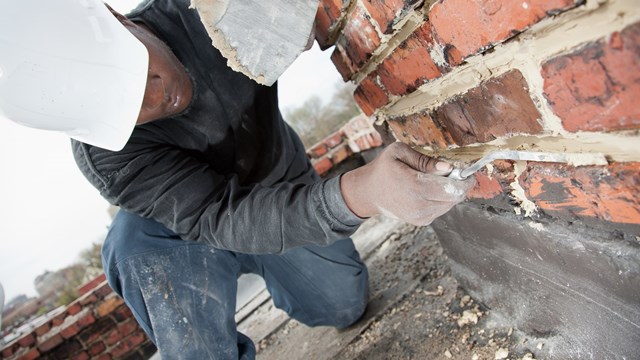
One of my young daughter’s favorite YouTube clips involves an elaborately decorated house, whose thousands of colored Christmas lights were programmed to flicker, strobe, wave, and blink to the tune of the Trans-Siberian Orchestra’s hard-rock holiday anthem “Wizards in Winter.” (The guy’s electric bill must have been through the well-lighted roof that December).
One of the benefits of living in a condominium is that your neighbor is not allowed to do to his unit what the guy in that video did to his. This is also, as the owner of the Trans-Siberian house would argue, one of the drawbacks. Living in a community means abiding by the rules of that community association, and when the holidays roll around, exterior decorations can become a thorny issue.
“It comes up every year,” says Ellen Hirsch de Haan, an attorney with Becker & Poliakoff, in Tampa Bay/St. Petersburg, “just like the holidays do.”
A miniature Stars and Stripes on the mailbox for the Fourth of July seems beyond reproach but what about festooning the front of your unit with zombie tombstones for Halloween, or a life-size Nativity scene for Christmas? How much is too much? And who gets to decide?
“HOAs—especially if they are single family homes—have greatly relaxed decorating policies for holiday décor,” says Evelyn Jasper, a regional director at The Continental Group, a property management company in Hollywood.
If anything, Jasper says that communities tend to regard holiday decorations as a way to bring the community closer together. “In Forest Ridge, a large-scale HOA in Davie, the community is encouraged to decorate, and prizes are awarded to the best decorated home,” she says.
Other HOAs are not as liberal. “Some associations encourage ‘tasteful’ holiday decorations, others limit the decorations not only by a time period but also by size and location (on the front door no bigger than a holiday wreath for example),” says Jasper.
With decorations, at the end of the day, it’s a matter of taste—and therein lies the rub. “The slippery slope is what constitutes ‘tasteful' decorations,” says Hirsch de Haan. “What I find tasteful versus what you find tasteful versus someone who wasn’t religious who might be offended at your decorations.”
Sherrill Schafer, the president and CEO of Community Management Concepts of Jacksonville, recalls many such aesthetical clashes. One association, a complex of detached units in a Southwestern architectural style, attracted a new owner with a weakness for Greek sculpture. No sooner had he moved in than he installed two enormous statues on his lawn—classical nudes. The other residents pitched a fit: not because the statues were ugly per se, but because they were not consistent with the look of the community as a whole. “The Greek naked statues,” she says, “were not in keeping with the Texan hill country community.” Eventually, the statues—which had come from the new owners’ much larger former residence—were removed.
Not only was this a question of taste; it was a question of individual versus collective aesthetics. “A lot of this has to do with the appearance of the community being consistent,” Schafer explains. “You want to maintain the integrity of the look of the community.”
It could be that the association in question consists of former art dealers of classical sculpture, in which case the Greek nudes might not have raised an eyebrow. “Part of the success of any community is having an architectural standards review committee that allows residents to have a say in what is allowed,” says Jasper.
Tastes can change over time. New owners may come in with a different sense of aesthetics. Thus, the rules should be open to revision. “Regular review of the association covenants for reasonableness and practicality is important,” Jasper says. “Asking the residents via a community survey is also a workable tool to assess how important the issue is to residents.”
This covers holiday decorations, too. Many associations would not be comfortable with one of their units being lit up to such a degree that it would inspire a viral YouTube clip. Schafer remembers a brouhaha that developed at a condominium complex because an owner put an enormous inflatable snowman on the lawn. No one had taken umbrage at Frosty, but like the Greek statues, the scale of the ornament turned some people off. This led to that HOA implementing a new rule the following year about “blow-up yard art.”
It should be noted that the blow-up yard art in question was located in the part of the yard under the jurisdiction of the owner. Common areas, it’s a different story.
“If you want to have a big blow-up snowman,” Schafer says, “you can’t put it in the common area.”
Decorations of a religious nature add a layer of complexity to the issue. On one hand, some religious decorations are protected by law. Mezuzahs on the door, for example, are a protected expression of religion, according to Florida law, and are not in the same category as, say, Christmas trees. “Mezuzahs are not considered to be a decoration,” Hirsch de Haan says.
On the other hand, religious decorations can be loaded politically. Some might take offense at, say, a giant Nativity scene on the front lawn. In certain cases, the decorations in question might be unprecedented within the community. For example, Schafer recalls an instance where an owner pitched what appeared to be a tent on the lawn, claiming this was in observance of a Jewish holiday. The board was not thrilled about such a large object on the lawn, but it was religious in nature—and not a giant blow-up snowman—they had to tread carefully; eventually, they allowed it to remain.
“The religious structure was a succah,” Schafer says, “and in 2009, the board granted the owner permission to place it at the front entrance of the unit only during the holiday season for five days.”
So how does an HOA get around the issue of decorations, especially ones that are religious in nature? The best way is to have clear, strict rules, and to abide by them.
“Limiting the time periods but allowing decorating as a community goodwill effort goes a long way to giving freedom, but not indefinitely,” Jasper says. In other words, it’s a good idea to implement a rule that states that holiday decorations must be deployed a week or three days before the holiday, and must be removed a week afterward.
Condos can be restrictive about this. “The covenants of the condo can and will govern when, what and where,” Jasper continues. “Some limit colors and some eliminate lights altogether. There simply are no consistent rules regarding holiday decorations from condo association to condo association.”
Another angle on the issue is when the association itself wants to get festive. “Can the association put decorations in the common areas?” muses Hirsch de Haan. “My suggestion is, if the association wants to decorate, they should 1) build it into the budget, so they have money to buy the decorations, and 2) discuss the issue in an open meeting, so people can express their opinion and come to a consensus.”
Indeed, decorating for the holidays—in a tasteful manner that residents form a consensus on—can be a great way to enhance the feeling of community that many residents seek out when buying into an HOA to begin with. If the community itself decorates, individuals are less likely to decorate themselves in ways that might overwhelm the collective aesthetic.
“In a condo, the proximity to each other provides for more annoyance factors,” says Jasper. “Limiting the style and type of decoration (no sounds, only white lights, size control, duration of posting) is the best way to appeal and meet the sensibilities of all residents. Compromise is paramount.”
This last point cannot be understated. The holidays—if the carols and songs of all the faiths are taken into account—are supposed to be a time of merriment, camaraderie, and good cheer, not about bickering over blinking lights and blow-up snowmen.
So how should HOAs handle the issue? “Compromise, community opinion via surveys, and legal limitations all must come into play,” says Jasper. “And ultimately, sometimes the best thing to maintain peace in the community is to ban decorations entirely. Without the support of the community by majority, that remains the best solution.”
The key is not to take things too far—and to keep the Trans-Siberian Orchestra light and magic show reserved for the sound stages and concert halls.
Greg Olear is a freelance writer and a frequent contributor to The South Florida Cooperator.






Leave a Comment